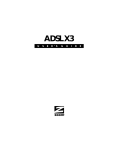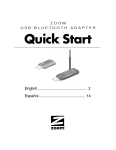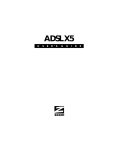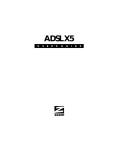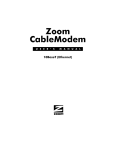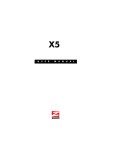Download Zoom USB External User`s manual
Transcript
Zoom Cable Modem U S E R ’ S M A N U Ethernet/USB External A L Contents CHAPTER 1: GETTING STARTED .............................................. 3 INFORMATION FOR CABLE SERVICE PROVIDER................................ 3 PACKAGE CONTENTS................................................................ 4 YOU WILL ALSO NEED ............................................................. 4 CHAPTER 2: INSTALLING YOUR CABLE MODEM ......................... 5 CONNECTING YOUR CABLE MODEM TO A COMPUTER’S ETHERNET PORT .................................................................... 5 CONNECTING YOUR CABLE MODEM TO A ROUTER ........................... 7 INSTALLING THE SOFTWARE—USB USERS ONLY ............................ 9 INSTALLING THE HARDWARE—USB USERS ONLY ..........................10 COMPLETING THE INSTALLATION ...............................................12 CHAPTER 3: USING YOUR CABLE MODEM ............................... 13 TO CONNECT TO THE INTERNET ................................................13 IF YOU UNPLUG YOUR CABLE MODEM OR LOSE POWER ...................14 IF YOU NEED HELP ................................................................14 APPENDIX A: TROUBLESHOOTING ......................................... 15 APPENDIX B: CONFIGURING YOUR TCP/IP NETWORK SETTINGS ........................................................... 19 APPENDIX C: HOW TO LOCATE YOUR ETHERNET MAC ADDRESS .................................................................. 24 APPENDIX D: CONFIGURING YOUR WEB BROWSER.................. 26 APPENDIX E: REMOVING THE CABLE MODEM SOFTWARE (USB OPTION ONLY) ................................................................... 30 APPENDIX F: REGULATORY INFORMATION ............................. 31 1 Getting Started Before you install your cable modem, you must have cable modem service with a cable company. Information for Cable Service Provider You must provide your cable service provider with the information summarized below, which is located on the bottom of your modem. Product Name: Zoom Cable Modem Model: __________ Serial No: ___________________________ MAC Address: _______________________ Some cable service providers will also ask for the MAC address of the computer or router that you plan to connect to the cable modem. Most routers and some computers have a label with this information. Appendix C also discusses how to find the MAC address of some computers. Chapter 1: Getting Started 3 Package Contents Your package contains the following items: • Cable modem • Ethernet cable • USB cable • Power cube • Software CD-ROM. The CD contains the installation software, documentation, warranty, and Customer Support information. If anything is missing or damaged, contact Zoom Customer Support or whoever sold you the modem. You Will Also Need • Any one of the following to connect to the modem: ! A Windows, Macintosh, or Linux computer with an Ethernet port. ! A Windows computer (Windows 98 or higher) with a USB port. (Only use the USB port if you cannot use an Ethernet port.) ! A wired or wireless router with an Ethernet port. • A power outlet for plugging in the cable modem. • Cable modem service provided by your cable company. The service must be compatible with your cable modem, which supports DOCSIS 1.0, 1.1, and 2.0. • A way to connect your cable modem to the cable company’s service. Your home may already have a cable with a connector that can attach directly to the cable modem. You may instead have a wall jack; and in that case, you will need a 75-ohm coaxial cable of the right length to connect from the wall jack to the cable modem. 4 Zoom Cable Modem User’s Manual 2 Installing Your Cable Modem This chapter describes how to install your cable modem. • To connect the cable modem to a router, skip to page 7. • If you have to connect the cable modem to your Windows computer’s USB port, go to Installing the Software on page 9. • Most users will connect the cable modem to a computer’s Ethernet port. To do that, follow the steps below. Connecting Your Cable Modem to a Computer’s Ethernet Port 1 Shut down the computer that you are going to connect to the cable modem. 2 Plug one end of the Ethernet cable into the modem’s LAN jack and plug the other end into your computer’s Ethernet jack. Tip: The modem has a fold-out base, so you can stand it upright or lie it flat, depending on your preference. Chapter 2: Installing Your Cable Modem 5 3 Connect the modem to the cable outlet. ! If you have a wall outlet cable jack: Connect one end of the coaxial cable to the modem’s CABLE connector and connect the other end to the wall jack. ! If you do not have a wall jack: You should have coaxial cable entering your house close to where you want to locate your cable modem. Connect the end of this cable to the modem’s CABLE connector. 4 Plug the included power cube into a power strip or wall outlet and then into the modem’s POWER jack. The modem performs an automated power-up process and registers with the cable system. When the process is complete, all the front panel lights—except for the LINK light—will stay on steady. (The table on page 15 lists the lights and their modes.) Note: It may take several minutes for the modem to register with the cable system. If the modem’s front panel ON LINE, US, and DS lights do not stay on steady after a reasonable amount of time, go to Troubleshooting Tips on page 15. 5 Turn on your computer. The modem’s LINK light comes on. 6 At this point, the equipment at your cable company will communicate with your modem and computer to finalize the installation. You should follow any directions that your cable provider has given to you. In some cases, everything will happen automatically. In other cases, your cable company may instruct you to phone back with your cable modem’s MAC address (see page 3) after you complete the hardware installation. The cable company may also request billing information. Congratulations! You have installed the hardware. Continue with the section Completing the Installation on page 12. 6 Zoom Cable Modem User’s Manual Connecting Your Cable Modem to a Router 1 The router should not be plugged in or powered up. If it is, unplug it. 2 Plug one end of the Ethernet cable into the modem’s LAN jack and the other end into the router’s WAN Ethernet jack, typically labeled WAN or Internet. Tip: The modem has a fold-out base, so you can stand it upright or lie it flat, depending on your preference. 3 Connect the modem to the cable outlet. ! If you have a wall outlet cable jack: Connect one end of the coaxial cable to the modem’s CABLE connector and connect the other end to the wall jack. ! If you do not have a wall jack: You should have coaxial cable entering your house close to where you want to locate your cable modem. Connect the end of this cable to the modem’s CABLE connector. 4 Plug the included power cube into a power strip or wall outlet and then into the modem’s POWER jack. The modem performs an automated power-up process and registers with the cable system. When the process is complete, all the front panel lights—except for the LINK light—will stay on steady. (The table on page 15 lists the lights and their modes.) Note: It may take several minutes for the modem to register with the cable system. If the modem’s front panel ON LINE, US, and DS lights do not stay on steady after a reasonable amount of time, go to Troubleshooting Tips on page 15. Chapter 2: Installing Your Cable Modem 7 5 Power-up the router. Wait for the router to complete its power-up sequence. The modem’s LINK light comes on. 6 You may need to restart some or all of the computers attached to the router. 7 At this point, the equipment at your cable company will communicate with your modem to finalize the installation. You should follow any directions that your cable provider has given to you. In some cases, everything will happen automatically. In other cases, your cable company may instruct you to phone back with your cable modem’s MAC address (see page 3) after you complete the hardware installation. The cable company may also request billing information. Congratulations! You have installed the hardware. Continue with the section Completing the Installation on page 12. 8 Zoom Cable Modem User’s Manual Installing the Software—USB Users Only Important! This section is only for Windows computer users who need to use the cable modem’s USB port. Windows computer users who are using the USB option MUST install the software BEFORE installing the hardware. Note, however, that you must remove any existing USB modem drivers on your Windows computer before beginning this software installation. On the desktop, click the Start button, and then— depending on your operating system—either click Control Panel, or click Settings and then Control Panel. In the Control Panel, double-click Add/Remove Programs. On the Add/Remove Program Properties dialog box, select the USB modem you are removing on the Install/Uninstall tab, click Remove, and then click OK. 1 Turn on the computer that you want to use to connect to the Internet. 2 Insert the supplied CD into the CD-ROM drive of your computer. The CD should start automatically. (If the CD does not start automatically, on the desktop, click the Start button, click Run, and then type D:\setup.exe, where D is the letter of your CD-ROM drive.) 3 Click Installation Wizard. 4 Click Next when prompted. 5 When the installation is complete, click Finish, then click Exit. Chapter 2: Installing Your Cable Modem 9 6 Close any applications that may be open, then remove the CD from the CD-ROM drive. 7 Shut down the computer. Congratulations! You have installed the software. Continue with the next section, Installing the Hardware—USB Users Only. Installing the Hardware—USB Users Only 1 Shut down the computer that you are going to connect to the cable modem. 2 Plug one end of the USB cable into the modem’s USB port and the other end into your computer’s USB port. Tip: The modem has a fold-out base, so you can stand it upright or lie it flat, depending on your preference. 3 Connect the modem to the cable outlet. ! If you have a wall outlet cable jack: Connect one end of the coaxial cable to the modem’s CABLE connector and connect the other end to the wall jack. ! If you do not have a wall jack: You should have coaxial cable entering your house close to where you want to locate your cable modem. Connect the end of this cable to the modem’s CABLE connector. 10 Zoom Cable Modem User’s Manual 4 Plug the included power cube into a power strip or wall outlet and then into the modem’s POWER jack. The modem performs an automated power-up process and registers with the cable system. When the process is complete, all the front panel lights will stay on steady. (The table on page 15 lists the lights and their modes.) Note: It may take several minutes for the modem to register with the cable system. If the modem’s front panel ON LINE, US, and DS lights do not stay on steady after a reasonable amount of time, go to Troubleshooting Tips on page 15. 5 Turn on your computer. You may see a Found New Hardware box indicating the progression of the installation. If you are prompted to restart your computer, please do so. You will be prompted to register your product with Zoom; if you prefer to register later, you can do so from your Windows desktop: Click the Start button, point to Programs, then point to Zoom Cable Modem, select Product Registration, and follow the prompts. 6 At this point, the equipment at your cable company will communicate with your modem and computer to finalize the installation. You should follow any directions that your cable provider has given to you. In some cases, everything will happen automatically. In other cases, your cable company may instruct you to phone back with your cable modem’s MAC address (see page 3) after you complete the hardware installation. The cable company may also request billing information. Congratulations! You have installed the hardware. Continue with the next section Completing the Installation. Chapter 2: Installing Your Cable Modem 11 Completing the Installation Please observe the following suggestions: • Do not block the modem vents in any way. Failure to allow proper air circulation can result in serious damage to the modem. Place the modem so that there is one inch of free space between its top and sides and any other device and the wall. • Do not place any items on top of the modem while it is plugged in. • Do not place the modem near a heating or air conditioning duct, in direct sunlight, or anywhere susceptible to drastic temperature changes. For many users, the cable modem installation is complete. Please refer to the bullet below to see if the following applies to you: • If you connected the cable modem to a Macintosh or Linux computer, your computer’s network settings need to be configured. Go to page 19 for instructions. Otherwise, continue with Chapter 3: Using Your Cable Modem. 12 Zoom Cable Modem User’s Manual 3 Using Your Cable Modem Now that you have installed your Zoom cable modem and it has synchronized itself with the cable network, your cable modem is ready to connect to the Internet. To Connect to the Internet To connect to the Internet, use your Web browser. If you are a Windows user and cannot connect, your Web browser settings may need adjustment. Your Web browser should be set to use a network connection (this might be called a “Local Area Network” or “broadband” connection). Refer to page 26 if you need help doing this. When you are done surfing the Web, close the browser. There is no need to unplug your modem. Your modem will remain connected with the cable system so that you can access the Internet at any time by opening your Web browser. Some cable companies request that you keep your modem on so that they can perform periodic software maintenance. However, if you do unplug your cable modem or if you lose power, you will have to wait while it powers up and synchronizes with the cable company before you can access the Internet. You can use the modem’s Ethernet option and the USB option simultaneously and provide Internet access to two computers if your cable provider supplies two IP addresses. Some providers offer this option for an extra fee. Consult your provider if you are interested. Chapter 3: Using Your Cable Modem 13 If You Unplug Your Cable Modem or Lose Power If you power down your cable modem, or if power is lost for any other reason, all communication between the modem and the cable system will be terminated. When power is restored, the modem will go through the full startup and synchronization process before you can connect to the Internet. If You Need Help Zoom has many Technical Support services available to its customers. You can access these services in a variety of ways: • Windows users: Insert the CD and then click the Customer Support link to view support information. There is also an electronic copy of this manual on the CD under the Documentation link. • Macintosh and Linux users: Insert the CD and navigate to the Mac_Linux folder to view documentation and support information. • Visit our Web site at www.zoom.com and select Technical Support. From here, you can send email to our technical support experts and/or do a smart search through our intelligent database by using SmartFacts™. • Call our support office in the United States at (561) 241-3216 or in the United Kingdom at 44 (0)1276 704440. • Some retailers of Zoom products provide support or can recommend a convenient support center. 14 Zoom Cable Modem User’s Manual Appendix A Troubleshooting This section provides tips to troubleshoot your cable modem. By referring to these tips, you may be able to quickly find a solution and avoid a call to Technical Support or your cable service provider. You may also want to refer to the Frequently Asked Questions (FAQs) located on the CD, or visit our Web site. Your Zoom cable modem has several lights on its front panel to help you monitor the modem’s status. Light Name Mode Status POWER Solid Power is on. DS (downstream) Blinking Modem is establishing a connection from the Internet to the computer. Solid Connection from the computer to the Internet is established. Blinking Modem is establishing a connection from the computer to the Internet. Solid Connection from the computer to the Internet is established. Blinking Modem is establishing a connection to the cable provider. Solid Modem connection to the cable provider is established. Blinking Data is flowing between the computer and the Internet. Solid Powered-up modem is connected to LAN device (e.g., computer, router). US (upstream) ON LINE LINK Appendix A: Troubleshooting 15 Problem: Solution: I cannot access my Internet service or send or receive email. All the modem’s front panel lights—LINK, ON LINE, US (upstream), DS (downstream), and POWER—must be solidly lit before your modem will work. If they are not: ! Check all modem connections. ! Check to see that your cable TV is working. ! Press the recessed RESET button on the back of the cable modem by using a paperclip. Press the button for a few seconds, release it, then wait for all the modem’s front panel lights to stay on steady. (Alternately, you can unplug your cable modem and then plug it back in.) ! Restart your computer. ! Check with your cable service provider to make sure that high speed access is available and running. ! In rare instances, the cable signal may be weak or noisy. If possible, try the modem at one of the ports on the first splitter after the cable enters the premises. ! Ethernet option users: Check that your Ethernet is functioning correctly. Refer to its documentation if necessary. ! Check that your TCP/IP settings are configured correctly. —Macintosh users, go to page 19. —Linux users, go to page 21. —Windows users, go to page 22. ! Check that your Web browser is configured correctly. It should be set to use a network connection (this might be called a “Local Area Network” or “broadband” connection). Refer to page 26 if you do not know how to check this. 16 Zoom Cable Modem User’s Manual Problem: Solution: I have connected a router to the cable modem but now cannot access the Internet or send or receive email. If the cable modem worked fine when connected to directly your computer, most likely the problem is caused by the router’s configuration or installation. First try shutting down and restarting each computer connected to the router. Allow the modem time to resynchronize with the cable system. If that does not solve the problem, your cable service provider may be using the cable modem’s MAC address and the MAC address of the device that the cable modem is plugged into. If you add a router and connect the cable modem directly to the router’s WAN port, you are changing the MAC address that is being used and sent to the cable service provider. You may need to contact your cable service provider and give them the MAC address of the router’s WAN port. The provider will then add this MAC address to their approved list, and you will be able to access the provider’s cable network using any computer connected to that router. You may also need to check that the DHCP client on the router’s WAN port is enabled. If you need help, look in your router manual or contact your router manufacturer. Problem: When I power-up my computer, I receive the onscreen message “Unknown Network Adapter.” Solution: This problem can result if the Ethernet or USB adapter hardware is physically present and recognized by Plug -and-Play, but the proper drivers were not installed; Windows may have added the device to the Other Devices list under Device Manager. Uninstall your cable modem (see page 30) and then reinstall it. Appendix A: Troubleshooting 17 Problem: I receive the on-screen message “Configure TCP/IP Failure Error.” Solution: First make sure that your Ethernet cable is plugged in, then unplug your modem from the electrical outlet for several seconds, and then plug it back in. Be aware it will take time for the modem to re-register itself and synchronize itself with the cable system. Problem: I receive the on-screen message “Undetected Network Adapter.” Solution: The Ethernet or USB adapter was not installed correctly. Uninstall your cable modem (see page 30) and then reinstall it. Problem: I receive the on-screen message “Missing Internet Protocol.” Solution: Your TCP/IP network settings may not be correct. ! Macintosh users, go to page 19. ! Linux users, go to page 21. ! Windows users, go to page 22. 18 Zoom Cable Modem User’s Manual Appendix B Configuring Your TCP/IP Network Settings If you are using a Macintosh or Linux computer, you must ensure that your computer’s TCP/IP network settings are configured properly. Otherwise, you will not be able to connect to the Internet. Note: If you are using a Windows computer, you do not have to configure the TCP/IP settings. This is because your Windows computer will automatically configure them for you. Windows users who are troubleshooting the cable modem may want to verify the TCP/IP settings. Depending on your operating system, follow the steps in the appropriate section to ensure your TCP/IP settings are correct. • If you are using Linux, go to page 21. • If you are using Windows, go to page 22. • If you are using Macintosh, continue below. Macintosh TCP/IP Settings Your Macintosh computer’s network settings depend on your Mac OS. For OS X, follow the instructions below. Otherwise, go to page 20. Mac OS X 1 From the Dock, choose System Preferences and then Network to display the Network pane. (For OS X 3, you also have to click the Configure button.) 2 Ensure that Automatic is selected from the Location list box. Appendix B: Configuring Your TCP/IP Network Settings 19 3 Under the Show drop-down tab (OS X 10.3.x) or the Configure drop-down tab (OS X 10.2.x), choose Built-in Ethernet. 4 Under the TCP/IP tab, make sure that Using DHCP is highlighted in the Configure: list box. Do not enter anything into the DHCP Client ID field. 5 Click Apply Now (or Save if prompted) and close the Network pane. Congratulations! This completes the installation of your modem. Go to Chapter 3: Using Your Cable Modem on page 13. Mac OS 7.6.1 - 9.2.2 1 From the Apple menu, choose Control Panels and then TCP/IP to display the TCP/IP Window. 2 Under Connect via:, select Ethernet built-in. 3 Under Configure:, select Using DHCP Server. Do not enter anything in the DHCP Client ID field. 20 Zoom Cable Modem User’s Manual 4 Close the TCP/IP Window. You will be asked if you want to save the changes. Click Save. Congratulations! This completes the installation of your modem. Go to Chapter 3: Using Your Cable Modem on page 13. Linux Network Settings The instructions for setting up boot-time DHCP vary dramatically by distribution, so you may want to refer to your particular version’s documentation. Note: If you have more than one network card installed, you will need to pick distinct Ethernet identifiers for each (eth0, eth1, eth2, and so forth). If you select an identifier other than eth0 for your cable modem, use that identifier throughout. RedHat Edit or create /etc/sysconfig/network-scripts/ifcfg-eth0 so that it contains the following three lines: DEVICE=eth0 ONBOOT=yes BOOTPROTO=dhcp Congratulations! This completes the installation of your modem. Go to Chapter 3: Using Your Cable Modem on page 13. SuSE Edit the file /etc/rc.config; search for the variables NETCONFIG, NETDEV_0, and IFCONFIG_0. Set them as follows (see the instructions in rc.config): NETCONFIG="_0" NETDEV_0="eth0" IFCONFIG_0="dhcpclient" Reboot with this command: /sbin/shutdown -r now. Congratulations! This completes the installation of your modem. Go to Chapter 3: Using Your Cable Modem on page 13. Appendix B: Configuring Your TCP/IP Network Settings 21 Debian Add this line to the file /etc/network/interfaces: iface eth0 inet dhcp Reboot with this command: /sbin/shutdown -r now. Congratulations! This completes the installation of your modem. Go to Chapter 3: Using Your Cable Modem on page 13 Windows TCP/IP Settings Your Windows computer’s network settings depend on your operating system. Please follow the instructions for your operating system below. Windows XP 1 Open the Internet Protocol (TCP/IP) Properties dialog box. a From the desktop, click the Start button, point to Control Panel, and then click Network and Internet Connections. b Click Network Connections. c Right-click the Local Area Connection icon, and select Properties. d Select your Ethernet card’s TCP/IP entry (it should include “TCP/IP” in it, but not “AOL,” “Dial-up,” or “Adapter”) and click the Properties button. 2 Ensure that Obtain an IP address automatically is selected and that either Obtain a DNS server address automatically or Enable DNS is selected. All fields should be blank. 22 Zoom Cable Modem User’s Manual Windows 2000 1 Open the Internet Protocol (TCP/IP) Properties dialog box. a From the desktop, click the Start button, point to Settings, then Network and Dial-up Connections. b Right-click the Local Area Connection icon, and select Properties. c Select your Ethernet card’s TCP/IP entry (it should include “TCP/IP” in it, but not “AOL,” “Dial-up,” or “Adapter”) and click the Properties button. 2 Ensure that Obtain an IP address automatically is selected and that either Obtain a DNS server address automatically or Enable DNS is selected. All fields should be blank. Windows 98/Me 1 Open the Internet Protocol (TCP/IP) Properties dialog box. a From the desktop, click the Start button, point to Settings, then Control Panel. b Double-click the Network icon to display the Network dialog box. c Select your Ethernet card’s TCP/IP entry (it should include “TCP/IP” in it, but not “AOL,” “Dial-up,” or “Adapter”) and click the Properties button and then click OK 2 Ensure that Obtain an IP address automatically is selected and that either Obtain a DNS server address automatically or Enable DNS is selected. All fields should be blank. . Appendix B: Configuring Your TCP/IP Network Settings 23 Appendix C How To Locate Your Ethernet MAC Address If you are using the Ethernet port of your cable modem, your cable company may ask for your computer’s Ethernet MAC address. This Appendix explains how to locate your Ethernet MAC address. The instructions vary depending on your computer type and operating system. Windows 2000/XP From the desktop, click the Start button, and then point to (All) Programs, then Accessories, and then Command Prompt. Type ipconfig/all and press Enter. Make a note of the 12-character Adapter Address on page 3 of this manual. Windows 95/98/Me From the desktop, click the Start button and then click Run. Type winipcfg, and click OK. Click more info, then select the Ethernet card you are using. The 12-character Adapter Address is your Ethernet card’s MAC address. Make a note of it on page 3 of this manual. Macintosh Macintoshes are sold with an Ethernet ID label affixed to them. If this label is missing from your Macintosh, you can determine the E -MAC address by following the steps below for the appropriate Mac operating system. Mac OS X 1 From the Dock, choose System Preferences and then Network. The Network pane appears. 24 Zoom Cable Modem User’s Manual 2 Under the Configure drop-down tab, choose Built-in Ethernet or Ethernet. 3 Make sure that the Ethernet tab (OS X 10.3.x) or the TCP/IP tab (OS X 10.2.x) is foremost. Find the 12-character Hardware Address (E-MAC address) and note it on page 3 of this manual. 4 Click Save and close the Network pane. Mac OS 7.6.1 - 9.2.2 1 From the Apple menu, choose Apple System Profiler. 2 In the Apple System Profiler window, click the Network Overview arrow and then the AppleTalk arrow. Find the 12character Hardware Address (E-MAC address) and make a note of it on page 3 of this manual. Linux 1 Right-click on the desktop and select Terminal or New Terminal. 2 At the prompt type ifconfig. The 12-character HWaddr listed next to the eth0 entry is your Ethernet card’s MAC address. Make a note of it on page 3. Appendix C: How To Locate Your Ethernet MAC Address 25 Appendix D Configuring Your Web Browser Important! This section is for Windows computers only. If you are using a Macintosh or Linux computer, go to Appendix B. When using a Windows computer, the software that you use to make an Internet connection must be set for a network connection, not a dial-up connection. This section includes instructions for recent versions of two popular Web browsers, Internet Explorer Version 5.0 (or later) and Netscape Navigator Version 7.2. Depending on the browser you have on your Windows computer, follow the corresponding instructions in this section. Tip: If you are using an earlier version of one of these browsers, the configuration may be slightly different from below. In those cases—or if you are using another browser altogether—configure the browser to use a network connection (this might be called a “Local Area Network” or “broadband” connection). 26 Zoom Cable Modem User’s Manual Configuring Internet Explorer The following instructions are for Internet Explorer Version 5.0 or later. (If you do not have this version, you can get a free upgrade from Microsoft Corp. If you are not sure what version you have, open Internet Explorer and from the Help menu, choose About Internet Explorer. The version number is directly below the Microsoft Internet Explorer logo. You can ignore all the numbers after the period following the first digit.) 1 On the desktop, right-click the Internet Explorer icon, and select Properties. Tip: If you cannot access Internet Explorer in this way, open your computer’s Control Panel (click the Start button and then, depending on your computer, either click Control Panel, or click Settings and then Control Panel). In the Control Panel, double-click the Internet Options icon. If this icon does not appear, double-click the Network and Internet Options icon and then double-click the Internet Options icon. 2 On the Internet Properties dialog box, select the Connections tab, then click the Setup button. Appendix D: Configuring Your Web Browser 27 3 The setup process will proceed differently, depending on your operating system. The following table details the process for your Windows computer. Windows XP a. On the Welcome to the New Connection Wizard dialog box, click Next. (If you see a Location Information dialog box, click Cancel and then when asked if you are sure you want to cancel, click Yes to return to the Welcome dialog box.) b. On the Network Connection Type dialog box, select Connect to the Internet, then click Next. c. On the Getting Ready dialog box, select Set up my connection manually, then click Next. d. On the Internet Connection dialog box, select Connect using a broadband connection that is always on, then click Next. e. On the Completing the New Connection Wizard dialog box, click Finish. Windows 98/Me/2000 a. On the Internet Connection Wizard dialog box, select I want to set up my Internet connection manually, or I want to connect through a local area network (LAN), then click Next. b. On the Setting up your Internet connection dialog box, select I connect through a local area network (LAN), then click Next. c. On the Local area network Internet configuration dialog box, uncheck the Automatic discovery of proxy server check box, then click Next. d. On the Set Up Your Internet Mail Account dialog box select No, then click Next. e. On the Completing the New Connection Wizard dialog box, uncheck the To connect to the Internet immediately, select this box… check box (if it appears) and click Finish. 4 If you accessed Internet Explorer’s settings from the Control Panel (as explained in the “Tip” following step 1), the Control Panel window will still be open. Close it before continuing. 28 Zoom Cable Modem User’s Manual Configuring Netscape Navigator The following instructions are for Netscape Navigator Version 7.2. (If you do not have Version 7.2, you can get a free upgrade from Netscape Communication Corp. If you are not sure what version you have, open Netscape Navigator and from the Help menu, choose About Netscape. The version number is at the top of the screen.) 1 Double-click the Netscape Navigator icon on your desktop to open the browser. 2 From the Edit menu, choose Preferences to open the Preferences dialog box. 3 In the Category list, click the triangle to the left of Advanced to display a list of choices below it, then select Proxies. The Preferences dialog box changes to show the Proxies you can specify. When you click this triangle, more options appear below Advanced. 4 Select Direct connection to the Internet, then click OK. Appendix D: Configuring Your Web Browser 29 Appendix E Removing the Cable Modem Software (USB option only) If you are a Windows user who connected the cable modem using its USB option and if you are unplugging the cable modem to use the USB port for something else, you need to remove the cable modem software before unplugging the modem. 1 Close any applications that are open. 2 From your Windows desktop, click the Start button, point to Programs, then point to Zoom Cable Modem, then select Cable Modem Uninstall. 3 Click Next. 4 Click Finish when prompted to do so. 5 Shut down your computer and then unplug the cable modem hardware from the USB port. 30 Zoom Cable Modem User’s Manual Appendix F Regulatory Information FCC Part 15 Emissions Statement This equipment has been tested and found to comply with the limits for a Class B digital device, pursuant to part 15 of the FCC Rules. These limits are designed to provide reasonable protection against harmful interference in a residential installation. This equipment generates, uses and can radiate radio frequency and, if not installed and used in accordance with the instructions, may cause harmful interference to radio communications. However, there is no guarantee that interference will not occur in a particular installation. If this equipment does cause harmful interference to radio or television reception, which can be determined by turning the equipment off and on, the user is encouraged to try to correct the interference by one or more of the following measures: Reorient or relocate the receiving antenna. • Increase the separation between the equipment and receiver. • Connect the equipment into an outlet on a circuit different from that to • which the receiver is connected. Consult the dealer or an experienced radio/TV technician for help. • Industry Canada Emissions Statement This Class B digital apparatus meets all requirements of the Canadian InterferenceCausing Equipment Regulations. Cet appareil numérique de la classe B respecte toutes les exigences du Règlement sur le matériel brouilleur du Canada. Electrostatic Discharge Statement This unit may require resetting after a severe electrostatic discharge event. Declaration of Conformity The manufacturer declares under sole responsibility that European models of this equipment comply to Directive 1999/5/EC (R&TTE Directive) via the following: Directives Standards 73/23/EEC IEC 60950-1 (2001) 89/336/EEC EN 55024 (1998) 89/336/EEC EN 55022 (1998) The product is CE marked. Appendix F: Regulatory Information 31 NOTICE This document contains proprietary information protected by copyright, and this Manual and all the accompanying hardware, software, and documentation are copyrighted. No part of this document may be photocopied or reproduced by mechanical, electronic, or other means in any form. The manufacturer does not warrant that the hardware will work properly in all environments and applications, and makes no warranty or representation, either expressed or implied, with respect to the quality, performance, merchantability, or fitness for a particular purpose of the software or documentation. The manufacturer reserves the right to make changes to the hardware, software, and documentation without obligation to notify any person or organization of the revision or change. All brand and product names are the trademarks of their respective owners. © Copyright 2004 All rights reserved. 3644-A 27319 ©2004


































